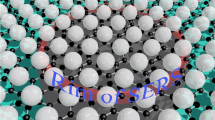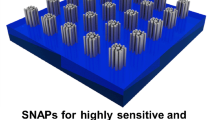Abstract
Surface-enhanced Raman scattering (SERS) is a molecule-specific ultra-sensitive spectroscopic technique. With the development of portable Raman equipment, it has become possible to apply the SERS technique for rapid on-site detection. Therefore, the search for materials with excellent surface plasmon resonance (SPR) activity and high stability has become an important research focus in recent years. In this study, we successfully prepared plasmonic nanostructures with a large number of SERS “hotspots” using alloy nanoparticles (NPs) with tunable gold–silver mole ratios. These structures were composed of numerous narrow gapped gold–silver alloy NPs with diameters ranging from 10 to 100 nm. SERS property evaluation showed that the prepared alloy SERS substrates had good uniformity, and the performance of the substrates rapidly improved as the Ag content increased. Gold-stabilized Au–Ag alloy SERS substrates combine the high performance of the Ag SERS substrate and the excellent stability of Au. In addition, the wavelength of the SPR can be tuned by adjusting the mole ratio of Au and Ag to satisfy different excitation wavelengths. Thus, the Au–Ag alloy SERS substrates we prepared show good comprehensive performance. The lowest concentration of rhodamine 6G that can be homogeneously detected by the prepared Au1Ag8 alloy substrate is 5 × 10−12 M, and the enhancement factor is 5.1 × 108. Finite-difference time-domain (FDTD) theoretical calculations further confirmed our experimental results and theoretically demonstrated the unique properties of the Au–Ag alloy SERS substrates.





Similar content being viewed by others
References
Nie SM, Emory SR (1997) Probing single molecules and single nanoparticles by surface-enhanced Raman scattering. Science 275:1102–1106
Kneipp K, Wang Y, Kneipp H, Perelman LT, Itzkan I, Dasar RR et al (1997) Single molecule detection using surface-enhanced Raman scattering (SERS). Phys Rev Lett 78:1667–1670
Yang SK, Dai XM, Stogin BB, Wong TS (2016) Ultrasensitive surface-enhanced Raman scattering detection in common fluids. Proc Natl Acad Sci U S A 113:268–273
Cui L, Zhang YJ, Huang WE, Zhang BF, Martin FL, Li JY, Zhang KS, Zhu YG (2016) Surface-enhanced Raman spectroscopy for identification of heavy metal arsenic(V)-mediated enhancing effect on antibiotic resistance. Anal Chem 88:3164–3170
Lee SY, Ganbold EO, Choo J, Joo SW (2010) Detection of melamine in powdered milk using surface-enhanced Raman scattering with no pretreatment. Anal Lett 43:2135–2141
Burr DS, Fatigante WL, Lartey JA, Jang W, Stelmack AR, McClurg NW et al (2020) Integrating SERS and PSI-MS with dual purpose plasmonic paper substrates for on-site illicit drug confirmation. Anal Chem 92:6676–6683
Fernandes de Oliveira Penido CA, Tavares Pacheco MT, Lednev IK, Silveira L (2016) Raman spectroscopy in forensic analysis: identification of cocaine and other illegal drugs of abuse. J Raman Spectrosc 47:28–38
López-Tocón I, Otero JC, Arenas JF, Garcia-Ramos JV, Sanchez-Cortes S (2011) Multicomponent direct detection of polycyclic aromatic hydrocarbons by surface-enhanced Raman spectroscopy using silver nanoparticles functionalized with the viologen host lucigenin. Anal Chem 83:2518–2525
Koh CS, Lee HK, HanX SHY, Ling XY (2018) Plasmonic nose: integrating the MOF-enabled molecular preconcentration effect with a plasmonic array for recognition of molecular-level volatile organic compounds. Chem Commun 54:2546–2549
Chou A, Jaatinen E, Buividas R, Seniutinas G, Juodkazis S, Izakea EL et al (2012) SERS substrate for detection of explosives. Nanoscale 4:7419–7424
Lin S, Hasi W, Lin X, Han S, Xiang T, Liang S, Wang L (2020) Lab-on-capillary platform for on-site quantitative SERS analysis of surface contaminants based on Au@4-MBA@Ag core−shell nanorods. ACS Sens 5:1465–1473
Liu YH, Wu H, Ma LW, Zou SM, Ling YH, Zhang ZJ (2018) Highly stable and active SERS substrates with alloy nanorods. Nanoscale 10:19863–19870
Gong TC, Luo YF, Zhang HB, Zhao CW, Yue WS, Pu MB, Kong WJ, Wang C, Luo X (2020) Hybrid octahedral Au nanocrystals and Ag nanohole arrays as substrates for highly sensitive and reproducible surface-enhanced Raman scattering. J Mater Chem C 8:1135–1142
Li KG, Liu GJ, Zhang S, Dai YQ, Ghafoor S, Huang WX, Zu ZW et al (2019) A porous Au–Ag hybrid nanoparticle array with broadband absorption and high-density hotspots for stable SERS analysis. Nanoscale 11:9587–9592
Yang H, Li BQ, Jiang XB, Shao JY (2019) Hybrid nanostructure of SiO2@Si with Au-nanoparticles for surface enhanced Raman spectroscopy. Nanoscale 11:13484–13493
Liu HM, Zhang XP, Zhai TR, Sander T, Chen LM, Klar PJ (2014) Centimeter-scale-homogeneous SERS substrates with seven-order global enhancement through thermally controlled plasmonic nanostructures. Nanoscale 6:5099–5105
Brust M, Walker M, Bethell D, Schiffrin DJ, Whyman R (1994) Synthesis of thiol-derivatized gold nanoparticles in a two-phase liquid-liquid system. J Chem Soc Chem Commun 1994:801–802
Ding SY, You EM, Tian ZQ, Moskovits M (2017) Electromagnetic theories of surface-enhanced Raman spectroscopy. Chem Soc Rev 46:4042–4076
Le Ru EC, Blackie E, Meyer M (2007) Surface enhanced Raman scattering enhancement factors a comprehensive study. Phys Chem C 111:13794–13803
Chen Y, Wang J, Xu T, Liu M, Liu J, Huang H, Ouyang F (2020) FDTD simulation of the optical properties for a gold nanoparticle-over-nanosheet hybrid structure. Curr Appl Phys 20:391–399
Qin F, Chen X, Yi Z, Yao W, Yang H, Tang Y, Yi Y, Li H, Yi Y (2020) Ultra-broadband and wide-angle perfect solar absorber based on TiN nanodisk and Ti thin film structure. Sol Energy Mater Sol Cells 211:110535
Funding
The authors received financial support from the National Natural Science Foundation of China (61735002, 61575007 and 11304005) and the Beijing Educational Commission (KZ202010005002 and KM201510005030).
Author information
Authors and Affiliations
Corresponding authors
Additional information
Publisher’s Note
Springer Nature remains neutral with regard to jurisdictional claims in published maps and institutional affiliations.
Electronic supplementary material
ESM 1
(PDF 268 kb).
Rights and permissions
About this article
Cite this article
Li, H., Liu, H., Qin, Y. et al. Gold-Stabilized Gold–Silver Alloy Nanostructures as High-Performance SERS Substrate. Plasmonics 15, 2027–2032 (2020). https://doi.org/10.1007/s11468-020-01229-0
Received:
Accepted:
Published:
Issue Date:
DOI: https://doi.org/10.1007/s11468-020-01229-0




